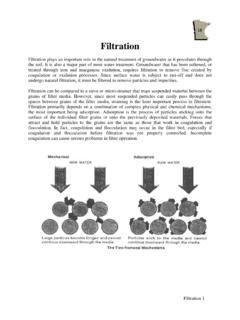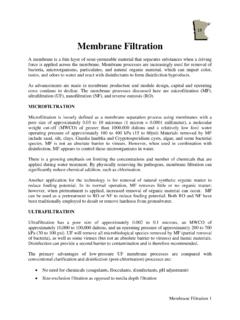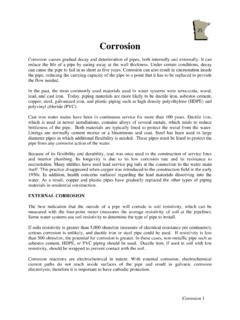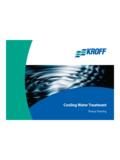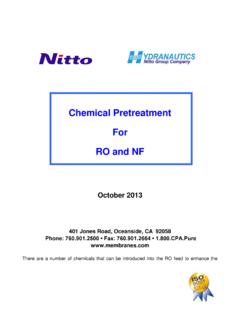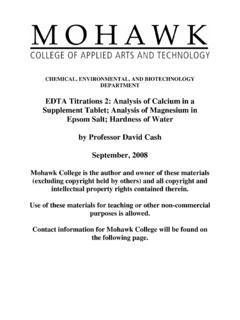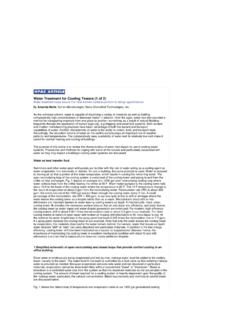Transcription of Lime-Soda Ash Softening - MRWA.com
1 Lime Softening 1 Lime Softening Chemical precipitation is one of the more common methods used to soften water. Chemicals normally used are lime ( calcium hydroxide, Ca(OH)2) and soda ash (sodium carbonate, Na2CO3). Lime is used to remove chemicals that cause carbonate hardness. Soda ash is used to remove chemicals that cause non-carbonate hardness. When lime and soda ash are added, hardness-causing minerals form nearly insoluble precipitates. calcium hardness is precipitated as calcium carbonate (CaCO3). Magnesium hardness is precipitated as magnesium hydroxide (Mg(OH)2). These precipitates are then removed by conventional processes of coagulation/flocculation, sedimentation, and filtration.
2 Because precipitates are very slightly soluble, some hardness remains in the water--usually about 50 to 85 mg/l (as CaCO3). This hardness level is desirable to prevent corrosion problems associated with water being too soft and having little or no hardness. LIME ADDITION Hardness Lime Precipitate CO2. + Ca(OH)2 -> CaCO3 + H2O Ca(HCO3)2 + Ca(OH)2 -> 2 CaCO3 + 2H20 Mg(HCO3)2 + Ca(OH)2 -> CaCO3 + MgCO3 + 2H20 MgCO3 + Ca(OH)2 -> CaCO3 + Mg(OH)2 CO2 does not contribute to the hardness, but it reacts with the lime, and therefore uses up some lime before the lime can start removing the hardness.
3 LIME AND SODA ASH ADDITION Lime MgSO4 + Ca(OH)2 -> Mg(OH)2 + CaSO4 Soda ash Precipitate CaSO4 + Na2CO3 -> CaCO3 + Na2SO4 CO2 = carbon dioxide, Ca(OH)2 = calcium hydroxide or hydrated lime, CaCO3 = calcium carbonate, Ca(HCO3)2 = calcium bicarbonate, Mg(HCO3)2 = magnesium bicarbonate, MgCO3 = magnesium carbonate, Mg(OH)2 = magnesium hydroxide, MgSO4 = magnesium sulfate, CaSO4 = calcium sulfate, H20 - water. Na2CO3 = sodium carbonate or soda ash Lime Softening 2 For each molecule of calcium bicarbonate hardness removed, one molecule of lime is used.
4 For each molecule of magnesium bicarbonate hardness removed, two molecules of lime are used. For each molecule of non-carbonate calcium hardness removed, one molecule of soda ash is used. For each molecule of non-carbonate magnesium hardness removed one molecule of lime plus one molecule of soda ash is used. CONVENTIONAL Lime-Soda ASH TREATMENT When water has minimal magnesium hardness, only calcium needs to be removed. Only enough lime and soda ash are added to water to raise pH to between and , and calcium hardness will be removed from the water (but minimal magnesium hardness will be removed). EXCESS LIME TREATMENT When magnesium hardness is more than about 40 mg/l as CaCO3, magnesium hydroxide scale deposits in household hot-water heaters operated at normal temperatures of 140 to 150 F.
5 To reduce magnesium hardness, more lime must be added to the water. Extra lime will raise pH above to help magnesium hydroxide precipitate out of the water. SPLIT TREATMENT When water contains high amounts of magnesium hardness, split treatment may be used. Approximately 80 percent of the water is treated with excess lime to remove magnesium at a pH above 11, after which it is blended with 20 percent of the source water. Split treatment can reduce the amount of carbon dioxide required to re-carbonate the water as well as offer a savings in lime feed. Since the fraction of the water that is treated contains an excess lime dose, magnesium is almost completely removed from this portion.
6 When this water is mixed with the water that does not undergo Softening , the carbon dioxide and bicarbonate in that water re-carbonates the final blend. Split treatment reduces the amount of chemical needed to remove hardness from water by 20 to 25 percent (a significant savings). DESIGN CONSIDERATIONS In lime soda-ash Softening plants, the Softening process may be carried out by a sequence of rapid mix, flocculation, and sedimentation or in a solids contactor. In the solids contactor the rapid mix, flocculation, and sedimentation occur in a single unit. The process begins with the mixing of the chemicals into the water, followed by violent agitation, termed rapid mixing.
7 This allows chemicals to react with, and precipitate calcium or magnesium hardness in the water. Lime Softening 3 Flocculation allows flocs to contact other flocs and grow large enough to settle in the sedimentation stage. Water is mixed gently with a small amount of energy. Most flocculators are compartmentalized, allowing for a tapered mix, so less energy must applied as the flocs grow in size. Detention time in the flocculator is important to allow particles to come in contact with each other. The minimum time recommended is 30 minutes for conventional water Softening . Sludge returned to the head of the flocculator reduces the amount of chemical needed and provides seed flocs for the precipitation.
8 The estimated return sludge is 10 to 25 percent of the source water. Sedimentation follows flocculation. Settling rates for these tanks are a function of particle size and density. Detention times in the settling basins range from hours to hours, and they can be rectangular, square, or circular (some designs incorporate inclined tube settlers). Lime Softening 4 Sedimentation can also occur in the solids-contact unit, in which the water is mixed with chemicals and flocculated in the center of the basin, then forced down and trapped for removal in a sludge blanket in the bottom of the tank. Sludge Removal Residue created from Lime-Soda ash Softening is normally very high in calcium carbonate or a mixture of calcium carbonate, and magnesium hydroxide.
9 calcium carbonate sludges are normally dense, stable inert, and dewater readily. Solids content in the sludge range from 5 to 30 total solids with a pH greater than Lime-Soda ash sludges may be treated with lagooning, vacuum filtration, centrifugation, pressure filtration, recalcination, or land application. The most common method is storage of sludge in lagoons and application to farmland or landfills disposal. Calculations There are two methods for calculating lime and soda ash dosages (conventional dosage method and conversion factor method). The conventional method, although much longer, is helpful in understanding the chemical and mathematical relationships involved in Softening .
10 The conversion factor method is simpler, quicker, and more practical for daily operations. In both calculation methods, lime and soda ash dosages depends on carbonate and non-carbonate hardness in the water. Lime is used to remove carbonate harness, and both lime and soda ash are used to remove non-carbonate hardness. If total hardness is less than or equal to total alkalinity, there is no non-carbonate hardness (only carbonate hardness). If total hardness is greater than total alkalinity, non-carbonate hardness equals the difference between total hardness and total alkalinity (and carbonate hardness equals total alkalinity). If total hardness is equal to or less than total alkalinity, then: Lime Dosage = the carbon dioxide concentration [CO2] + the total hardness concentration [Total Hardness] + the magnesium concentration [Mg] + [Excess] Optimum chemical dosages can be evaluated with a jar test.
